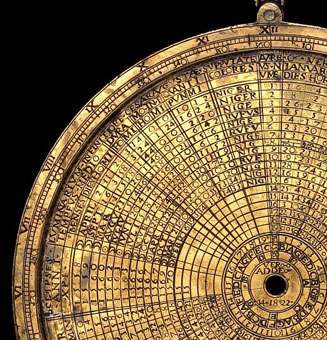Astrolabes /
Browse / 48892

| Date | 1558 |
| Maker | Jacobus Valerius (?) |
| Place | Zaragosa |
| Material | Brass |
| Inventory no. | 48892 |
| Acquisition | Presented by Lewis Evans in 1924 |
Only the mater of this astrolabe survives - not the rete or the latitude plates - but it demonstrates an ambitious interest in astronomy and the capacity of the astrolabe for dealing with the whole of the cosmos. The table of numbers inside the mater is used to calculate oppositions, conjunctions and eclipses of the sun and moon for the Spanish town of Zaragosa, referred to by its Latin name, Caesar Augusta. The back has 13 concentric astronomical scales, including planetary data, and an unusual projection of the celestial sphere.
View all
images for this astrolabe
View
detailed provenance for this astrolabe
Mater
The mater and limb are of two pieces, soldered construction. Scales on the limb: equal hours scale; degree scale.The limb is inscribed: with a direction marked as AVSTER (South wind). This inscription is found on the edge of the limb. with a direction marked as AVSTERAFRIC9 (South-west wind). This inscription is found on the edge of the limb. with a direction marked as LIBS (West-south-west wind). This inscription is found on the edge of the limb. with a direction marked as ZEPHIRVS (West wind). This inscription is found on the edge of the limb. with a direction marked as ARGESTIS (West-north-west wind). In classical Latin, Argestis was the West south-west wind. Here it clearly has to be the West north-west wind. This inscription is found on the edge of the limb. with a direction marked as CIRCIVS (West-north-west wind). This inscription is found on the edge of the limb. with a direction marked as SEPTENTRIO (North wind). This inscription is found on the edge of the limb. with a direction marked as AQVILO (North north-east wind). This inscription is found on the edge of the limb. with a direction marked as HELESPONTI9 (North-east wind). This inscription is found on the edge of the limb. with a direction marked as SVBSOLAN9 (East wind). This inscription is found on the edge of the limb. with a direction marked as VVLTVRN9 (South-east wind). This inscription is found on the edge of the limb. with a direction marked as EVROAVSTER (South south-east wind). In classical Latin, Euroauster would indicate the south-east wind. This inscription is found on the edge of the limb. More information
Back
The back bears a number of astronomical and astrological tables, along with more typical scales found on the backs of astrolabes. The back contains 0 scales. More information